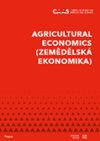贝叶斯分位数能告诉我们主要农产品期货之间的波动传导吗?
IF 1.8
4区 经济学
Q2 AGRICULTURAL ECONOMICS & POLICY
引用次数: 5
摘要
本文研究了玉米、小麦、大豆和稻谷四种农产品期货的异质波动溢出效应。为了避免波动率的偏差测量,我们使用了马尔可夫切换广义自回归条件异方差(MS-GARCH)模型。创建的波动率嵌入到贝叶斯分位数回归框架中,可以产生准确的分位数估计。我们报告说,大豆和小麦受到来自其他市场的相对较高的波动性冲击,这排除了大豆和小麦作为投资组合中的主要投资资产。另一方面,大米在所有其他农产品期货中受到的波动冲击最小。原因可能是亚洲和太平洋地区国家实施的大米价格稳定政策。这一结果有利于大米期货作为投资组合中的主要资产。所有其他期货都适合作为大米组合的辅助资产,因为大米受其他三个市场波动冲击溢出效应最弱。本文章由计算机程序翻译,如有差异,请以英文原文为准。
What Bayesian quantiles can tell about volatility transmission between the major agricultural futures?
This paper investigates an idiosyncratic volatility spillover effect between the four agricultural futures – corn, wheat, soybean, and rise. In order to avoid biased measurements of the volatilities, we use the Markov switching generalized autoregressive conditional heteroskedasticity (MS-GARCH) model. The created volatilities are imbedded in the Bayesian quantile regression framework which can produce accurate quantile estimates. We report that soybean and wheat receive relatively high levels of volatility shocks from the other markets, and that excludes soybean and wheat as primary investment assets in a portfolio. On the other hand, rice receives the lowest amount of volatility shocks from all other agricultural futures. The reason could be the policy of rice price stability that is conducted by countries in the Asia and Pacific region. This result favours rice futures, from the four commodities, as the primary asset in a portfolio. All other futures are suitable to be an auxiliary asset in a portfolio with rice, because rice receives the weakest volatility shocks spillover effect from the other three markets.
求助全文
通过发布文献求助,成功后即可免费获取论文全文。
去求助
来源期刊

Agricultural Economics-Zemedelska Ekonomika
Agricultural Economics & Policy-
CiteScore
4.30
自引率
4.50%
发文量
47
审稿时长
30 weeks
期刊介绍:
An international peer-reviewed journal published under the auspices of the Czech Academy of Agricultural Sciences and financed by the Ministry of Agriculture of the Czech Republic. Published since 1954 (by 1999 under the title Zemědělská ekonomika).Thematic scope:
original scientific papers dealing with agricultural subjects from the sphere of economics, management, informatics, ecology, social economy and sociology. Since 1993 the papers continually treat problems which were published in the journal Sociologie venkova a zemědělství until now. An extensive scope of subjects in fact covers the whole of agribusiness, that means economic relations of suppliers and producers of inputs for agriculture and food industry, problems from the aspects of social economy and rural sociology and finally the economics of the population nutrition. Papers are published in English.
 求助内容:
求助内容: 应助结果提醒方式:
应助结果提醒方式:


